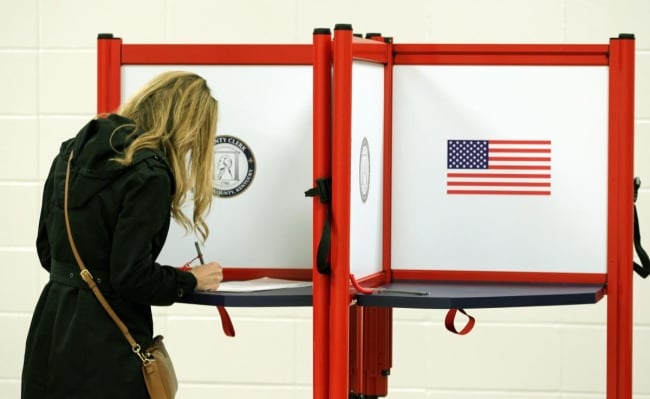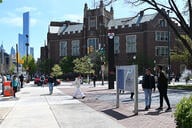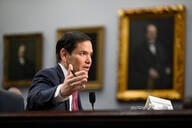You have /5 articles left.
Sign up for a free account or log in.

John Sommers II/Getty Images
Sacred Heart University students were particularly motivated to vote on Election Day last week. For some students, it would be their first time voting. Others had been heavily involved in an on-campus voter registration drive and were eager to cast their ballots against a local politician.
The students knew they would be asked for identification to prove they were eligible to vote, but none were prepared for what happened when they showed up at a local polling place in Bridgeport, Conn., near the university's campus in Fairfield.
Poll workers openly mocked them, questioned them aggressively about their state residency and challenged their use of certain forms of identification.
“Shouldn’t you be in school?” Someone blurted out at one polling place. “Go back to your home state,” another person said. A few students said they were called “stupid.”
Student government leaders said they were insulted. University administrators saw this as a form of intimidation and an attempt to suppress the student vote.
“It was my first time voting,” said Olivia Chaponis, a 19-year-old from Massachusetts and the sophomore class president. “It was a very weird experience to not have your voice wanted to be heard. It’s not something that we’re told is normal.”
While such open hostility directed at young voters is not the norm at most polling places, tensions between college students and politicians and elections officials are more common across the country now that college students are an influential and contested voting bloc. Local and state politicians are increasingly trying either to court student voters or to limit their impact on election outcomes. Voting rights activists and election officials are butting heads every election season, as a result.
Things are not likely to change in the run-up to the 2020 U.S. presidential election. Americans are deeply politically divided, and partisanship is at an all-time high in Congress and in statehouses across the country. There are also clear generational divides between young voters, who tend to be politically liberal, and the politicians who are actively promoting and passing laws requiring college students to jump through more hoops to vote -- moves that voting-rights proponents allege are efforts to keep the students from voting.
"Young people are bigger than the boomers now," said Nancy Thomas, director of the Tufts University Institute of Democracy and Higher Education, which measures student voting at colleges and universities during major election years. "They’re a formidable bloc, and they are going to get targeted for suppression. The thing about college students is they are easy to locate."
Voter turnout among 18- to 29-year-olds went from 20 percent in 2014 to 36 percent in 2018, according to the U.S. Census Bureau. The 79 percent jump was the largest percentage-point increase for any age group, the bureau said.
Student turnout for the midterm elections last year jumped from 29.6 percent in 2014 to 55 percent in 2018, according to the institute. Thomas said efforts to suppress the student vote are expected to ramp up in future elections.
"Republicans have been doing this for years for various groups, and I think they didn’t have to worry as much about college students," Thomas said. But now they're going after students because of their increased participation in electoral politics, she said.
Republican state lawmakers have said their intent is to reduce election fraud, but some of these politicians also take a dim view of colleges actively encouraging students to vote and consider such activities partisan in nature.
Student participation in politics was apparent in Kentucky, where a tight race for governor between Matt Bevin, the Republican incumbent, and Andy Beshear, a Democrat, touched on state funding of higher education and the affordability and accessibility of college. These issues piqued the interest of Northern Kentucky University students, said Mark Neikirk, executive director of the university's Scripps Howard Center for Civic Engagement.
Bevin and Beshear held their final debate on the campus of Northern Kentucky on Oct. 29, which further drew students’ attention to the election, Neikirk said. The university's active voter-registration efforts also contributed to increased political engagement by students, he said.
It was a “fairly visible election” compared to previous years, and the entire state, including students, showed strong interest and turnout, he said.
“Specific to Northern Kentucky, funding for higher education in the state is something students reference a lot,” Neikirk said. “They have a strong awareness right now that the pension crisis is impacting the state budget’s ability to invest in other areas … You wouldn’t normally get a 20-year-old talking about the pension crisis, but you will on this campus.”
Although demographic breakdowns of voters from last week's elections are not yet available, student voter turnout in 2019 is expected to remain high based on anecdotal reports from college campuses, said Michael Burns, national director of the Campus Vote Project for the Fair Elections Center, a legal advocacy group for voting rights.
Young Invincibles, a group that advocates for youth voter participation, monitored voting at college campuses in Virginia on Election Day and recorded a "pretty high voter turnout increase," said Clarissa Unger, the organization's director for civic engagement.
Burns said there was miscommunication between students and local elections officials in Virginia and Iowa about registration and identification requirements.
Iowa passed a voter-identification law that went into effect this year. The law now requires preregistered voters to show a state-issued voter identification card at the polls; voters who registered on Election Day could show proof of local residency, such as a bill showing a local address, and any state license. This discrepancy confused some out-of-state college students in Iowa, who thought proof of residency and a non-Iowa license would suffice if they were already registered, Burns said. It was not the first time that college students felt thwarted from voting by the state.
The Fair Elections Center also heard reports from Virginia students, who had changed their registration to vote near their colleges, Burns said. When they arrived at the polls, they learned their designated polling places were in locations not near their colleges.
"One student was positive that they were registered, voted in Richmond last year, but was told that they were registered under their home address," Burns said. "This isn't the first time that we’ve heard that students are being told that they aren’t residents and they shouldn’t vote locally … People believe students are there for only a short time, but we don’t make other folks sign a pledge that they’re going to live there for 10 years or more. Students are also stand-ins for future students who live there."
The students at Sacred Heart University seemed to run into this very situation when they were ridiculed and challenged by the local election workers. While long-simmering tensions between students that attend the Roman Catholic university and neighborhood residents, particularly in Bridgeport, were also a factor, it was clear that some people didn't think students who don't live there year-round should have a say in local elections, said Deb Noack, Sacred Heart’s director of communications.
Carlos Ruiz, 20, a junior, experienced this firsthand when he went to vote at the same local elementary school in Bridgeport where poll workers name-called his classmates. Ruiz provided Sacred Heart's address instead of his address in Bridgeport when asked. “Of course you don’t know where you live,” a poll worker said. Students often use Sacred Heart’s official address for receiving mail, and some, including Ruiz, were called “stupid” for mistakenly recording it as their Bridgeport address, Noack said.
Some students were required to sign affidavits that stated their local addresses and sent home to get proof of registration, which was mailed to them. Out-of-state students were asked to show Connecticut driver's licenses, which they are not required to do under state law, Noack said.
Student Government president Denisse Rodriguez, who is from New York, said there were discrepancies in what students were asked to provide if they went to the same polling place in the morning or the afternoon. She was permitted to vote with her New York driver’s license, she said. Democratic Bridgeport registrar Sandi Ayala did not reply to multiple requests for comment.
In the lead-up to the 2018 midterm elections, laws that violated students’ voting rights sparked intensified voter registration and turnout efforts, Unger said.
"Students, in particular, showed that they are a very powerful voting bloc," she said. "A number of groups in our coalition did a lot of work in 2018 to reverse some laws that discouraged putting early voting sites on campus."
Unger believes that Republicans and Democrats alike engage in suppression tactics directed at college students.
“This comes from both sides of the aisle,” she said. “It happens regardless of who is in power.”
The “borderline voter suppression” in Bridgeport, which is largely controlled by Democrats and has been for some time, is in line with how lawmakers and election officials elsewhere have attempted to thwart student voters.
"For a population that’s newer to elections, it’s very easy for them to get derailed if the local election official or poll worker has inaccurate information or is treating them poorly," Burns said.
It was a local issue that made the Sacred Heart students want to vote. A zoning ordinance proposed by several Bridgeport City Council members and Mayor Joseph Ganim in early October would limit the maximum number of people permitted to live in a single household from four to three. The measure seemed directed at the many college students renting homes in North End, a neighborhood known for noisy parties and not enough parking spaces to accommodate both students and locals.
When the ordinance was proposed, students took offense to how the mayor and other elected officials were stereotyping them, said Ruiz, who organized a student voter registration campaign at Sacred Heart called PioneerVote. The mayor described North End in a press release as “a college dormitory run amok” and said it once was a quiet neighborhood that is now overrun with students. PioneerVote had already registered 900 students before the mayor’s remarks, but his comments helped fuel the movement to get out the student vote.
“Students didn’t find that acceptable,” Ruiz said of the mayor's rhetoric. “Students tend to be the scapegoat of the issues of the town. I do recognize the concerns that the residents of North End in Bridgeport have, but that generalization of students helped get out the vote.”
Students showed up on Nov. 5 to vote against Councilwoman Michelle Lyons, who represents the 134th District, which encompasses North End, hoping to throw her out of office. But she won narrowly over rival AmyMarie Vizzo-Paniccia.
Lyons said she became the face of the housing ordinance and student outrage, even though the ordinance was never meant to target Sacred Heart. Its primary purpose was to improve living conditions for students and residents by enforcing the city's rent laws, she said. The ordinance would improve public safety and address the frequent complaints of her constituents, who, she said, have seen as many as nine students living in one house at a time.
“It was initiated [so] that they would have a voice due to an ordinance that we hadn’t even issued yet, and it took off,” Lyons said. “There was a sleeping bear here, and the sleeping bear got woken up, and it shook up some things."
As far as Sacred Heart students are concerned, the bear was never asleep in the first place. They believe their university is ranked 13th for student political awareness in the Princeton Review’s Best Colleges for good reason.
"Even though the result isn’t what was expected, it definitely got a lot of the local residents worried and concerned," Ruiz said. "The message was that students are not going to go anywhere … There was talk of a student presence, and we made that happen, we made that be felt."




